| |
Rainwater harvesting manual released in Nairobi, Kenya
Nairobi's deputy mayor, Charles Kiyo Muratha, released the publication
'A rainwater harvesting manual for Nairobi' at a meeting
held at National Museum of Kenya, on December 7, 2004. A model
rainwater harvesting project was also inaugurated at the venue
on the same day, followed by a seminar.
Centre for Science and Environment (CSE) has published the manual
in collaboration with RELMA
(Regional Land Management Unit) in ICRAF (International Centre
for Research in Agroforestry), Nairobi. It is a compilation of simple
rainwater harvesting techniques suitable for urban areas and also
has case studies of successful initiatives from Nairobi, New Delhi
and Bombay.
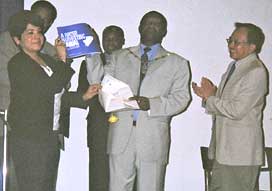 |
| Charles
Kiyo Muratha, Deputy Mayor Nairobi (centre), and CSE's Sumita
Dasgupta (left) at the release function |
Speaking on
the occasion, Sumita Dasgupta, Coordinator, Jal Swaraj Campaign,
CSE, spoke about the universality of water scarcity in urban areas.
She said that although Nairobi gets over 900 mm rainfall over nine
month every year; the city faces acute water shortage. Most of the
city's water supply sources are over 150 kilometres away.
Dasgupta admitted that the situation is no better in most Indian
cities. "But we have learnt how to manage the resources and
make use of the precious gift - rain," she said. The manual,
she added, is a guide to rainwater harvesting practices that can
be implemented easily.
Deputy mayor Muratha said: "Water is becoming increasingly
scarce in Nairobi. We need to take steps to popularise rainwater
harvesting to conserve this precious resource." He said that
the government has pledged to create a specific body to support
this movement. He exhorted the people of Nairobi to adopt rainwater
harvesting to ease the stress on the municipal supply and to ensure
year-round availability of safe water.
Bashir Zaman, Deputy
Director General, ICRAF, stressed upon the urgency of preserving the
catchments for Nairobi's water supply system. He said that
the catchments are quite far from the city and are being threatened
by rapid erosion, deforestation and pollution. He suggested that a
plantation drive be undertaken to reduce soil erosion and increasing
the natural infiltration in the catchments.
Addressing the large gathering, comprising engineers, architects,
planners, and representatives from NGOs, educational institutions,
government officials, researchers, journalists, and interested citizens
of Nairobi, Miambo Malesu, Regional Coordinator, RELMA, emphasised
the need for long-term collaboration with NGOs like CSE, which have
done pioneering work in the field of rainwater harvesting. He urged
those present to "water on the seed" by taking active interest
in the model rainwater harvesting project at the National Museum of
Kenya.
Model rainwater harvesting project at National Museum of Kenya
A model rainwater harvesting project got underway at the biodiversity
block of National Museum of Kenya, Nairobi, on December 7, 2004.
Centre
For Science And Environment (CSE) and Regional Land Management Unit
(RELMA), Nairobi, have jointly set up the project as part of an
effort to spearhead a rainwater harvesting movement in Kenya. Charles
Kiyo Muratha, Deputy Mayor of Nairobi, inaugurated the project.
National Museum of Kenya in Nairobi was selected because it:
- gets a large number of visitors everyday
- is easily accessible
- had some of the required infrastructure
Experts from CSE along with National museums of Kenya jointly inspected
the site and targeted the Biodiversity block as a model site for the
project. Salahuddin Saiphy, a CSE expert on rainwater harvesting,
designed the system. It was quite challenging to complete the construction
work with a short period. In order to achieve the target John Mbugua,
a Nakuru based contractor worked very hard with his team and Saiphy
supervised the implementation.
The basic objectives of the model project are:
- To act as a catalyst in spreading water literacy
- To reinstate and reaffirm the potential of rainwater harvesting
- To provide concrete evidence to citizens to indicate potential
of rainwater harvesting'
- To stabilise the imbalance between water supply and its demand
The rainwater harvesting system was designed keeping in view the large
section of the society. The system not only collects rainwater for
non-potable purposes like cleaning, washing, gardening and use in
toilets but also for drinking purposes from KWS Strong room's rooftop
covered with galvanised iron sheets. The concept of recharge well
was also being introduced for groundwater recharge for the first time
in eastern Africa.
The rainwater harvesting system includes:
- A ferro-cement tank of 20,000 litre capacity - for non potable
purpose
- A recharge well - for groundwater recharge
- A PVC tank of 3500 litre capacity - for drinking purpose
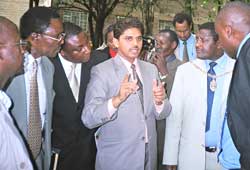 |
|
CSE's
Salahuddin Saiphy explaining the working of a rainwater system |
Construction
work at the site also attracted a lot of visitors to the museum
and got briefing from the CSE expert about the project and its objective.
The ferro-cement tank was selected for storage because of its low
cost and simple technology. A ferro-cement tank can be easily constructed
by a mason and later maintained by the community. The tank is located
on the eastern corner of the building. The site selection for the
tank was done very carefully so that the gravity head can be used
to supply water to the toilets located downstream. The overflow
from the tank and rooftop water from a small portion of the building
is recharged into the ground with the help of a recharge well located
next to the tank. The recharge well is 1.5 m x 1.5 m x 2 m and provided
with a recharge bore 100 mm diameter and 10 m depth. A PVC tank
is also used to collect rainwater from the rooftop having galvanised
iron (GI) sheet, as rainwater collected from the sheets is considered
fit for drinking. A Nairobi-based PVC tank manufacturer, Kantainers,
donated the tank. Its objective was to create a model for small
household, which can store rainwater in tanks and use it during
the dry spell for drinking and cooking requirements.
The site was visited by a number of people including deputy mayor,
deputy DG, ICRAF, Principal, University of Nairobi, representatives
from various NGO, engineers, students and individuals. Explaining
the working of the system, Saiphy said that the storage in ferro-cement
tank is very cost effective and involves very simple technology
that can be implemented by a mason. "We have used locally available
material and manpower," said Saiphy. It was highly appreciated
by visitors and recharge well was of much interest for them as it
was a new technique introduced for the first time in Nairobi
 |
Seminar on Rainwater Harvesting
A seminar on rainwater harvesting was also organised as part of
the event comprising the release of a manual and the inauguration
of a model rainwater harvesting project in the National Museum of
Kenya, Nairobi.
A large largely number engineers, university students, and interested
individuals attended it. Orodi Odhiambo, lecturer, Department of
Environment and Biosystems Engineering, University of Nairobi, spoke
on potential of rainwater harvesting in Nairobi. He said that if
done on large scale, it can solve the water problems of the city.
William Wambugu, manager, Botanical gardens, National Museums of
Kenya also shared his experiences.
Salahuddin Saiphy, a rainwater harvesting expert from CSE, made
an audio-visual presentation during the seminar. He said that the
purpose of rainwater harvesting is not merely to store rainwater
for direct use, but also to recharge groundwater.
Ground water recharge is an effective tool to arrest the sharply
declining water table in the area. He also shared the experiences
of rigorous monitoring of CSE"s rainwater harvesting projects
in Delhi and confirmed that most of the projects have experienced
a remarkable rise in water table after rainwater harvesting or check
the sharply declining water levels. He elaborated the concept and
principles of rainwater harvesting focusing both on storage as well
as groundwater recharge. He also unveiled the success stories from
Mumbai and Delhi highlighting the issues related to implementation,
maintenance and monitoring.
The seminar ended with a lively discussion. The number and variety
of the questions posed by the participants revealed their interest
and curiosity. Majority of the queries were related to the water
quality, campaign and CSE's impact on policy makers. There were
few questions regarding groundwater recharge technique also as it
was a new concept and being introduced for the first time in Nairobi.
Salahuddin Saiphy and Sumita Dasgupta jointly answered the questions.
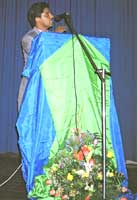 |
|
Salahuddin
Saiphy making an audio visual presentation during the seminar
|
Lecture on Rainwater Harvesting- Experiences from India at University
of Nairobi
On the invitation
from University of Nairobi, on December 8th 2004, Salahuddin
Saiphy from Centre for Science and Environment delivered a lecture
at University of Nairobi. The lecture was focused on principles and
techniques of rainwater harvesting with case studies from India.
The university officials present in the seminar during the Rainwater
Harvesting Manual release function at National Museums of Kenya were
so influenced by CSE staff's presentation that the representatives
of the Department of Environment and Biosystems Engineering met him
personally and invited to deliver a lecture for its faculties and
students. Salahuddin Saiphy of JalSwaraj Camapign, CSE spoke at a
length about the concept, principles and different techniques of rainwater
harvesting. He nicely used the model rainwater harvesting projects
in Delhi to detail the different techniques of RWH. He also unveiled
the results of CSE monitoring in model projects to confirm the potential
of rainwater harvesting. He also screened the 90 seconds public service
advertisement on rainwater harvesting produced by CSE to sensitise
the participants. Cheering faces of the participants validated that
they really enjoyed it. Many of the participants requested for a copy
of the presentation and film and looking at the interest a copy was
given so that it can be used for imparting knowledge to the peoples
who could not attend the workshop.
Poster
exhibition on techniques of Rainwater Harvesting at Nairobi
 |
|
Poster
exhibition on techniques of Rainwater Harvesting at Nairobi |
On the occasion
of launch of Rainwater Harvesting Manual for Nairobi and model
project site inauguration at National museums of Kenya, CSE put
its poster exhibition on water. The exhibition was a collage of
nice posters depicting traditional rainwater harvesting practices,
principle and concept of RWH. The exhibition also covered the CSE's
model RWH projects and results of monitoring. Maiambo Malesu, Regiaonal
Coordinator RELMA appreciated CSE's poster exhibition and said"
it is a very rich and colourful exhibition which not only attracts
visitors but also clearly teaches RWH. A group of Nairobi University
students also requested for the copy of all the posters to be used
in their environment festival.
 |
Large turnout at workshop on wastewater management
A two-day workshop on Decentralised Wastewater Treatment Systems
(DEWATS) held in New Delhi on November 5 and 6, 2004 drew an enthusiastic
response from various quarters.
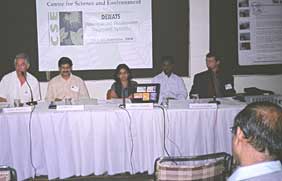 A
large number of architects, engineers, representatives of local
NGOs, officials from government agencies like INTCAH, CGWB, DJB,
HUDCO, DDA and institutions like SPA, IIT Delhi as well as industries
were among the participants. A
large number of architects, engineers, representatives of local
NGOs, officials from government agencies like INTCAH, CGWB, DJB,
HUDCO, DDA and institutions like SPA, IIT Delhi as well as industries
were among the participants.
The event, which was held at Indian Habitat Centre, New Delhi, was
jointly organised by the Centre for Science and Environment (CSE)
and Pondicherry-based NGO, Auroville Centre for Scientific Research
(CSR). The workshop was sponsored by European Union, Borda - Dewats
Indian projects.
In his keynote address, Sunita Narain, director, CSE, highlighted
the need for decentralised wastewater management instead of centralised
treatment systems. She highlighted how Delhi, in spite of having
maximum number of treatment plants, could not clean up the Yamuna.
The CSE director also released a film on DEWATS produced by CSR.
The film explains how the DEWATS system works with the help of animations
and case studies.
After the inauguration function, Pedro Kraemer, coordinator, FEDINA
- BORDA spoke about their campaigns to spread the concept of decentralised
wastewater management systems. Kraemer said that out of 2,902 big
and small cities in India, 93 per cent of do not have sewage treatment
plants. And the plants in the few cities that have them are not
up to the mark.
In the technical session, Tency Beatens from CSR shared his experience
on wastewater management in Auroville. He said that a lot of effort
had gone in making the plants effective so that they can fit in
the urban scenario.
A technical presentation on Total Water Management then followed.
Lata Raman from Inspiration, a Kerala-based NGO, conducted the session.
Raman explained how they had incorporated rainwater harvesting and
wastewater management using DEWATS through case studies from Kerala
and Maharashtra.
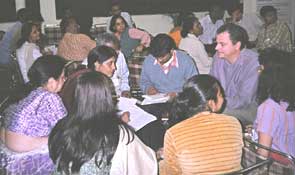 Thereafter,
Durga Venkateswami and Kiran Vaghela from Hunna Shaala, a Gujarat-based
NGO, gave a joint presentation. They explained how DEWATS can be
used for treating wastewater at community level through proper planning. Thereafter,
Durga Venkateswami and Kiran Vaghela from Hunna Shaala, a Gujarat-based
NGO, gave a joint presentation. They explained how DEWATS can be
used for treating wastewater at community level through proper planning.
The highlight of the first day's presentation was Dr Lucas Dengal's
speech, in which he spoke about a different technology, Effective
Microorganisms. He explained how the microorganisms derived from
molasses could be utilised for treating wastewater.
The second day of the workshop began with a presentation by Pedro
Kraemer, in his presentation he explained in detail to the architects
and engineer how to design a decentralised wastewater treatment
system. He explained about various designing parameters, components
and its implementation methodology and monitoring aspects.
After this presentation, the participants were divided into groups.
The groups were given basic inputs about CSE's new building and
were asked to come up with a wastewater treatment plant design.
This was a challenging job for the participants since the space
available to install the system was very limited. But the groups
presented their ideas and designs, which clearly showed that they
had got the basics right.
 |
Free training programme on
Decentralised Wastewater Treatment Systems (DEWATS)
for architects, engineers and professionals
A two-day training programme on decentralised wastewater treatment
systems (DEWATS) is being organised in Delhi by the Auroville Centre
for Scientific Research, Borda, India Project and Centre for Science
and Environment (CSE), New Delhi.
|
Programme
schedule
Date: November 5-6, 2004,
from 9:30 am to
5 pm
Venue: Core 6-A, 4th Floor
India Habitat Center, New Delhi - 110003
Contact: Mr R. K. Srinivasan
Centre for Science and Environment (CSE)
41, Tughlakabad Institutional Area
New Delhi - 110062
E-mail: rksri@cseindia.org
Tel: +91 (011) 29955124; 29956110, 29956394,
29956399 (Ext. 219)
Fax: +91 (011) 29955879 |
The programme aims to promote awareness and encourage wider implementation
of the technology, and will be held from November 5-6, 2004 at India
Habitat Centre, New Delhi.
Decentralised wastewater treatment technology has caught up in the
Western world as a viable and cost-effective technique. India too
is looking at this technology to combat the growing menace of water
pollution.
Today, several national and international agencies are promoting
decentralised wastewater treatment technology, due to its advantages
over the conventional centralised sewage collection and treatment
systems. The advantages include lower cost of sewage collection
and maintenance of sewerage systems, cost-effective treatment technology,
easy management of the wastewater due to its lesser volume, utilisation
of recycled sewage, involvement of developers, builders and users
in wastewater treatment and management.
DEWATS are able to treat domestic wastewater and industrial wastewater
with similar characteristics as domestic sewage up to 1000 cubic
metres per day.
On the first day, participants will be introduced to DEWATS technologies.
On the second day, they will be expose to the designing aspects
of DEWATS. The concepts will be explained with the help of numerous
examples.
The training programme is meant for architects, engineers and practising
professionals who are interested in the implementation of decentralised
wastewater treatment systems.
The training is entirely free. But only those participants who have
attended the first day will be allowed to attend the second day
of the programme.
Those interested can apply before October 31, 2004.
Organised by
Auroville Centre for Scientific Research (CSR)
Centre for Science and Environment (CSE), New Delhi
Sulabh International Institute of Technical Research and Training
Sponsored by
Borda—Dewats India Project, Bangalore, Karnataka
Bremen Overseas Research and Development Association (BORDA), Germany
European Union (EU)
Council of Architects, New Delhi
More about the sponsors
Bremen Overseas Research and Development Association (BORDA),
Germany
Borda's areas of work comprise measures in international development
cooperation, in integrated environmental protection and the promotion
of environmentally compatible technologies. BORDA cooperates with
scientific and development organizations and individuals at home
and abroad.
The DEWATS India Project is a private cooperation between German
and Indian NGO's financially supported by the European Union (EU)
and the Federal Ministry for Economic Cooperation and Development,
Germany (BMZ).
The aim of the project is to support small- and medium-sized enterprises,
institutions and communities in planning, designing and constructing
effective, reliable, cost-efficient and custom-made wastewater treatment
systems.
Auroville Centre for Scientific Research (CSR)
CSR has focused since 1984 on applied research in the area of renewable
energies, appropriate building technologies and water and sanitation.
The effort of treating wastewater through decentralised natural
methods is part of an integral program to ensure a sustainable water
management policy for Auroville. During a 20-year period, pilot
systems were built, practical experience was gathered and the operating
skills for handling Dewats plants were fine-tuned.
At present, Auroville operates more than 50 Dewats plants for recycling
both 'grey' and 'black' domestic wastewater.
Centre for Science and Environment (CSE), New Delhi
The Centre for Science and Environment (CSE) is a public interest
research and advocacy organisation, which promotes environmentally
sound and equitable development strategies.
As a part of its natural resources management programmes, CSE has
been promoting rainwater harvesting as a practical solution for
meeting water scarcity and recharging the fast depleting groundwater
table. With its campaign—People's management of water, that
aims to make water everybody's business, CSE is striving to revive
community-based rainwater harvesting systems.. Awareness generation,
capacity building, networking, technical services and policy research
are the integral part of CSE’s campaign on water.
Council of Architecture (COA)
COA regulates both the education and practice of architecture
within India. It aims at maintaining world standards of this profession
through legal, professional and educational means. As part of its
mission, COA also provides practicing professionals and teachers
in the field with regular publications, seminars and workshops.
Sulabh International Institute of Technical Research and Training,
New Delhi
Sulabh is engaged in the development of new and sustainable technologies.
It is active in disseminating information, providing demonstrations,
training and consultancy in the field of decentralised wastewater
treatment systems, solid waste management, and low cost sanitation.
 |
CII workshop on rainwater harvesting in Dehradun
A workshop on Urban Rainwater Harvesting: Techniques and Case Studies
held in Dehradun on October 8, 2004 drew an enthusiastic response
from industries, NGOs, schools, local administration and senior
citizens of the city.
The event, which was held at Hotel Madhuban, was organised by Confederation
of Indian Industry (CII) northern region, Uttaranchal state unit.
Officials from Centre for Science and Environment (CSE) gave presentations
on various aspects of rainwater harvesting at the workshop.
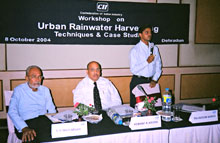 |
(From
left) CII's D N Mazumdar and Hemant K Arora (Vice-Chairman,
CII,
Uttaranchal) watch as CSE's Salahuddin Saiphy makes a presentation |
In his keynote
address, Hemant K Arora, Vice-Chairman, CII Uttranchal State Council,
said that India has 16 per cent of the world's population but only
four per cent of water. The percentage of the urban dwellers has trebled
over the past 50 years. He added that President APJ Abdul Kalam has
asked all state governments to give priority to rainwater harvesting.
Jal Yodha, a film produced by CSE was also screened on the occasion.
The film introduces viewers to the technique and management practices
governing community water management.
CSE's Salahuddin Saiphy detailed the growing desperation over water
in major cities of India. He attributed the water crisis in India
despite good monsoons to improper management of water resources.
Saiphy said that the water supply problems caused by Dehradun's altitude
and topography could be mitigated to some extent by adopting rooftop
rainwater harvesting (RWH).
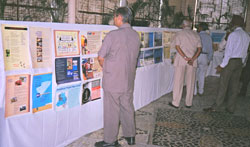 |
| Exhibition
on rainwater harvesting techniques |
He later outlined
the major components of RWH system and said that storing the rainwater
in storage tanks for direct use is a good practice that can be adopted
in Dehradun, keeping in view the rainfall pattern and hydro-geological
conditions.
The meeting ended up with a lively discussion. The participants
unanimously agreed that it is time to practise water conservation
techniques like RWH. The participants also requested CSE officials
to visit them and suggest an RWH scheme. The participants also enjoyed
the exhibition of posters on urban RWH put up at the venue.
 |
Training programme on water management for NTPC engineers
On September 1-2, 2004, a two day training programme on RWH
was organized for thirty civil engineers from National Thermal Power
Corporate (NTPC), a leading Public Sector Undertaking (PSU) of the
Government of India.
CSE and NTPC were jointly organizing similar programs for the last
three years.
The training curriculum included traditional and contemporary water
harvesting techniques in both urban and rural areas. A visit was
to the recently launched Raincentre
(RC) in Meerut was also organized. Anil Rana, President, Janhit
foundation, the host of RC, explained the water harvesting system
at the centre. He also shared his experiences on water management
in Uttar Pradesh in general and Meerut in particular.
For more details:
RK Srinivasan, CSE
Ashis K Chatterjee, NTPC
 |
Paryavaran Sammelan vows to protect waterbodies
in Baghpat
On August 29, 2004, Jeevan Surabhi Sewa Sansthan and Prakriti
Bachao Andolan, Baghpat based NGOs jointly organized a Payavaran
Sammelan (meeting on environment) was organised in Khekda in Baghpat
district of Uttar Pradesh. The meeting was attended by Sarpanchs
from different villages, local leaders, senior citizens and students.
The objective was to sensitize the villagers.
Baghpat, once dotted with numerous waterbodies is heading towards
a water crisis. The district has already been declared a dark zone
and the waterbodies are being heavily encroached. During his speech,
Omveer Tomar, Director, Jeevan Surabhi Sewa Sansthan appealed the
citizens to maintain and protect the water bodies and free them
from encroachments. He also urged the local administration and judiciary
to be more proactive when it comes to protecting the waterbodies.
Chaudhary Noor Hasan, Sarpanch of Ratol a village in Baghpat, during
his speech recollected that the area used to be one of the largest
exporters of Ratol, a special variety of mangoes. Absence of desired
soil moisture has resulted in the poor yield of mangoes, which has
resulted in the decline in the mango orchards. Besides this, irrigation
mostly from groundwater has become costlier due to steep decline
in water levels. He also insisted on the tree plantation as the
number of tree is sharply declining in the area.
The CSE staffer, highlighted the ironical situation that the country
faces-droughts and floods. He called upon the audience to manage
water resources efficiently. He also outlined the importance of
traditional water harvesting practices in water management. The
importance of conserving existing water bodies and other groundwater
resources were also highlighted. He opined that rainwater harvesting
is a simple yet effective technique to replenish our water resources.
The meeting ended with a resolution to "conserve the existing
water bodies, construct new waterbodies in wastelands and increase
the vegetation in the area" so as to preserve the natural resources.
For more details:
Omveer Tomar
Jeevan Surabhi Sewa Sansthan
Teacher Colony
Nehru Road
Baraut,
Baghpat, Uttar Pradesh
09837422262
 |
CSE addresses students and citizens in Meerut
On August 19, 2004, Uttar Pradesh Housing and Development Board
(UPHADB) organised an awareness programme on rainwater harvesting
in Meerut. Around 120 students and large number of architects, engineers
and senior citizens attended the seminar.
The main objective of the programme was to involve school children
to spread the message of RWH harvesting to a larger section of the
society. Hari Gopal, superintending engineer, UPHADB expressed his
concern over alarmingly depleting water levels in the city and appealed
the citizens to conserve water at all fronts.
CSE staffer started his audiovisual presentation by screening a
film on rainwater harvesting. He indicated that mismanagement of
water resources has resulted in series of disasters like droughts
and floods in India. He also shared some of the facts and figures
of Meerut's water resources. Later he spoke about the principles
and components of rainwater harvesting. He also elaborated the methods
and techniques - how to implement RWH in a building.
H M Raut, Principal, Deewan Public school summerised the programme
and appealed the students to take the message to their homes and
actively involved into the campaign.
 |
Seminar for industries of Gurgaon
On 16th August 2004, a workshop was organised for the managerial
level representatives of the industries of Gurgaon, at Unitech Country
Club, Gurgaon. The workshop was organised by Eco Profit, a Gurgaon
Based NGO. The objective of the workshop was to train the companies
in the field of integrated environmental production & service
policy at all level to minimize the environmental impact and ensure
continuous sustainable development.
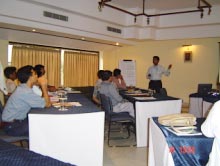 |
|
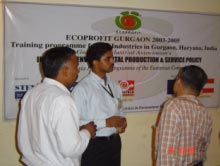 |
| CSE
staffer during his audio visual presentation |
|
Interacting with the participants |
During the event CSE staffer made a presentation on the rainwater
harvesting (RWH) techniques. In his presentation he spoke about the
deteriorating quantity and quality of water resources in urban environment
due to uncontrolled urbanization and industrialization and increasing
gap in demand and supply of water in Gurgaon. Later he explained the
concepts and principles of RWH and insisted on the dare need of industries
adopting it in view of sharply declining water levels in area. He
cited the examples of RWH system of Hero Honda and Tex Corp limited
that how industries can ensure adequate water availability by implementing
RWH system. He also shared the experiences of monitoring the CSE's
model rainwater harvesting of Delhi, Gurgaon and Noida.
Efficient water flow management, Life cycle thinking, Eco design,
Audit and efficient audit tools were some other topics covered during
the workshop over two days.
 |
Plumbers and masons training in Delhi
CSE trained plumbers, masons and small contractors on Rainwater
Harvesting (RWH) techniques at its Tughlakabad office on 18th august
2004. The objective of the training was to impart the training to
the real implementers of RWH structures and to generate the resource
base in the city.
Full day training programme was divided into two sessions- theoretical
and practical.. During the theoretical session Sumita Dasgupta,
Coordinator Jal Swaraj spoke about CSE's campaign. CSE staffer outlined
the griming water scarcity in most of Indian citied because of negligence
of traditional water harvesting practices and uncontrolled use of
water resources. They were not only taught the concept, principles
of RWH but also how to design the structures. Some tips for economical
and good quality construction were also shared with them.
During the second session- practical session, the participants were
asked to plan a rainwater harvesting scheme for a given site plan.
All participants made a scheme of RWH. Some of the participants
presented their designs and actively participated in the discussion.
"Jal Yodha" 22 minutes long film on water was also screened
at the occasion.
 |
Kolkata gets
tips on rainwater harvesting
A seminar on rainwater harvesting
was organised in Kolkata, West Bengal,
on August 10, 2004. Experts from Centre for Science and Environment
(CSE)
were invited to speak on the potential of harvesting rain to address
the water crisis in the city.
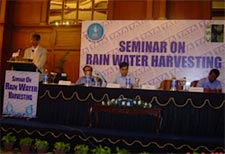 R
Bandyopadhyaya, principal secretary, Water Investigation and Development,
of the West Bengal government inaugurated the event, organised by
Tata Pipes. Architects, builders, representatives of NGOs and government
officials were among those who attended the event. R
Bandyopadhyaya, principal secretary, Water Investigation and Development,
of the West Bengal government inaugurated the event, organised by
Tata Pipes. Architects, builders, representatives of NGOs and government
officials were among those who attended the event.
In his inaugural address, Bandyopadhyaya said that a study conducted
by his department concluded that the conical depression developed
due to fall in water level in late 1950s has spread over most of
the city, especially South Kolkata. “If the situation prevails,
it may lead to seawater intrusion,” he said.
R.K. Srinivasan, deputy coordinator, Natural Resource Management
Unit, CSE, explained the basic concepts of rainwater harvesting
and then gave a detailed presentation on the water scenario in Kolkata.
He also shared the results of impact monitoring studies conducted
at CSE’s rainwater harvesting model projects in New Delhi.
D. Prakash, regional director of Central Ground Water Board (CGWB)
spoke
about the CGWB-funded pilot rainwater harvesting project at Patoli.
In the interaction session that followed, the participants asked
a lot of questions regarding various technical and policy aspects
of rainwater harvesting.
 |
Awareness programme on rainwater harvesting
in Agra
On August 6, 2004, the Agra division of the Uttar Pradesh State
Pollution Control Board organised an awareness programme on rainwater
harvesting, and CSE was invited to provide an insight on the potential
of this system, especially in the context of the city. The programme,
which targetted school children, teachers and municipal officials,
was inaugurated by the District
Magistrate, Mahesh Kumar Gupta.
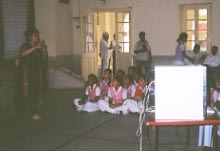 The
session held in two phases and attended by about three hundred people—was
extremely interactive. Sumita Dasgupta, Coordinator, Natural Resource
Management Unit, CSE, explained the basic concept of RWH and then
presented in details the water scenario in Agra city. She explained
the relevance of the technology vis-à-vis Agra and concluded
with suggestions on how this initiative on spreading water literacy
among the citizens can be carried forward. The
session held in two phases and attended by about three hundred people—was
extremely interactive. Sumita Dasgupta, Coordinator, Natural Resource
Management Unit, CSE, explained the basic concept of RWH and then
presented in details the water scenario in Agra city. She explained
the relevance of the technology vis-à-vis Agra and concluded
with suggestions on how this initiative on spreading water literacy
among the citizens can be carried forward.
The students came up with a volley of questions and expressed great
interest in understanding the role they can play in conserving and
management of water.
In his speech, the DM mentioned that in Agra ground water level
has depleted by 8m in the last few decades. Hence creating awareness
among public about rainwater harvesting is the need of the hour.
He also announced that his administration plans to provide small
grants to institutions who implement rainwater harvesting in their
premises.
 |
Training Workshop for Engineers
CSE organised a full day training programme for civil engineers
on rainwater harvesting on August 4, 2004 at its Tughlakabad office.
The engineers were attached with Bharat Sanchar Nigam Limited and
working in different parts of the country like Ahmedabad, Bangalore
Chennai, Guwahati, Ernakulam, Kolkata, Delhi and Mumbai. The programme
was conducted in collaboration Advanced Level Telecom Training Centre
(ALTTC), Ghaziabad.
The training programme was divided into two sessions- theoretical
and practical. Audio visual presentation started with screening
the 90 seconds public service advertisement on rainwater harvesting
and was deeply appreciated by the audiences.
During the theoretical session that started with Jalswaraj Campaign,
urgency of water management and scope of rainwater harvesting in
griming water situation in the country left participants in a shock.
Laws and legislations in different cities like Delhi, Chennai, Indore,
Kanpur, Mumbai and Bangalore were discussed. Engineers were not
only given the introduction of basics and principals of rainwater
harvesting but also exposed to planning and designing aspects of
rainwater harvesting structures in detail. Experiences from the
CSE's Model rainwater harvesting projects were also shared with
participants.
During the second session- practical session participants were shown
the rainwater harvesting system of CSE's building and later Jamia
Hamdard University. There not only they saw different RWH structure
but also interacted with the host of the project, Mr Ahmad Ali,
Executive Engineer, Jamia Hamdard University.
While coming back to the class rooms they were asked to design RWH
system in a given site plan. All of them calculated total annual
RWH potential of the site and designed the scheme. Few participants
also made presentation of their designs.
The programme ended up with the feedback session and Rustam Vania,
Co-ordinator, Environment Education Unit distributed certificates
to all participants.
 |
Training Programme for plumbers
in Kanpur
Plumbers, masons and contractors were trained by CSE staffers in
Hotel Bliss, Kanpur on August 3, 2004. The objective of the program
was to equip the plumber with the technology of rainwater harvesting
and prepare them for implementation. It was a day long training
programme, divided into two sessions- theoretical and practical
session. About 35 plumbers, masons attended the program.
During the theoretical session, Salahuddin Saiphy and R K Srinivasan
from Jal Swaraj Campaign, CSE briefed about the griming situation
of water in major Indian cities including Kanpur. In Kanpur, deteriorating
water quality and declining water table is the major concern as
far as the water is concerned. The basics and principals of rainwater
harvesting were elaborated to the participants in detail. Planning
and designing aspects were also introduced to them.
During the practical session, the participants were taken to the
terrace of the hotel where they measured the dimensions of the building
and demarcated the location of rainwater pipes on the site plan.
Later they themselves calculated the annual water harvesting potential
of the site and designed the rainwater harvesting scheme. Group
leaders also presented their designs and thorough discussion among
the participants and trainers resulted in a cost effective and suitable
structure.
"Boond- Boond Se Ghat Bhare", a film on traditional water
harvesting practices and 90 seconds public service advertisement
on rainwater harvesting were also screened during the event and
were deeply appreciated by the audiences.
List of plumbers, trained during CSE's Training Programme on Rainwater
harvesting at Hotel Bliss, Kanpur, July 3, 2004
| S. No. |
Name
|
Address |
Phone
no. |
| 1.
|
Debendra Singh |
132/38, Baradavi
Chowraha, Kanpur |
2641073 |
| 2.
|
Amar |
7/116, Saroop Nagar, Kanpur |
9839100649 |
| 3.
|
Ganesh Chander das |
7/116, Saroop Nagar, Kanpur |
3210577 |
| 4. |
Dwarika
Das |
84/224, Karwal Nagar, Kanpur |
9415133731 |
| 5. |
Sripal Gupta |
336/ML, HARAH Kanpur |
|
| 6. |
Raj kumar singh |
83/8, Govind
Nagar, Kanpur |
2652823 |
| 7. |
Hari Nagar |
104/264, C.P. Road, Kanpur |
9839533131 |
| 8. |
Nand Kishore |
75/32, Halsi Road, Kanpur |
- |
| 9. |
Ramji |
141/A, PateL Nagar, Kanpur |
|
| 10. |
Akhoy |
60/116, Swarup Nagar, Kanpur |
231260 |
| 11. |
Kamlesh kumar |
127/284, W-I, Swaket Nagar,
Kanpur |
2608449 |
| 12. |
M.D.
Rafiq |
105/257, Prem Nagar, Kanpur |
2553699 |
| 13. |
Om Prakash |
50 K 2, BARAH, Kanpur |
2681520 |
| 14. |
Ashok Kumar |
141/A, Patel Nagar, Kanpur |
-2400871 |
| 15. |
Ramu |
78/4, Anwar ganj, Kanpur |
|
| 16. |
Amarnath |
9/A/B, BARAH, Kanpur |
2681520 |
| 17. |
Sripath |
Rawatpur, Kanpur |
2291694 |
| 18. |
Yogendra |
Govindnagar, Kanpur |
3813947 |
| 19. |
Ram
Prasad |
97/1, Kidwai Nagar, Kanpur |
|
| 20. |
Bijay Kumar |
Srinagar,
Suklagang, Kanpur |
|
| 21. |
Santosh kumar |
A Block 669, Kanpur |
|
| 22. |
Mnoj Kumar |
BARAH, Kanpur |
|
| 23. |
Amrit Lal |
12/480,
Makra Kanpur |
|
| 24. |
Surendra Gupta |
MANGLABIHARIST |
|
| 25. |
Mohmad Idrish |
116/936 Rawatpur |
2501096 |
| 26. |
Shakil |
Machalia,
Kanpur |
|
| 27. |
MD Islam |
Rawatpur, Kanpur |
|
| 28. |
Bahadur |
85/65 HALVA, Kanpur |
|
| 29. |
Bablu |
85/65 ,
HALVA, Kanpur |
|
| 30. |
M. D. Arif |
116/936 Roshan Nagar, Kanpur |
|
| 31. |
Sharma ji |
Ranapratapnagar, Kanpur |
|
| 32. |
Dashrath Singh |
30, Usman pur
Colony, Kanpur |
|
| 33. |
Rashey shyam |
209, Ambedkar nagar, Kanpur |
|
| 34. |
Prithvi pal mourya |
107/2 Jareeb Chowk Chauraha,
Kanpur |
3093954 |
| 35
|
Barkatullah Siddiqui |
21/1 Ompurwa, Kanpur |
9839116839240384 |
 |
Training Programme for plumbers
in Ghaziabad
On August 2, 2004 a training program for plumbers and masons was
organised in Shipra Hotel, Ghaziabad. The objective of the program
was to impart training on the basics and design aspects of rainwater
harvesting and to generate the resource base in implementation sector.
The day long training programme was divided into two sessions- theoretical
session and practical session. About 54 participants attended the
program which includes plumbers, masons, tube well drillers and
small contractors.
During the theoretical session, Salahuddin Saiphy from Jal Swaraj
Campaign, CSE outlined the national water scenario focusing on major
Indian cities. The widening demand and supply gap in almost every
city and increasing dependence on groundwater resources was elaborated
in detail. R K Srinivasan, Dy. Coordinator Natural Resource management
Unit, CSE not only taught basics and principals of rainwater harvesting
but also shared experiences from the model rainwater harvesting
projects.
How to plan and design rainwater harvesting structures in a building
were elaborated in detail by Salahuddin Saiphy. Specifications for
making the structures and the precautions to be taken during the
implementation were also discussed in detail.
During the second session- practical session, the participants were
taken to the terrace of the hotel. The participants measured the
dimensions of the building and demarcated the location of rainwater
pipes and bore well on the site plan. All participants calculated
the annual water harvesting potential of the site and designed the
rainwater harvesting scheme. Some of the plumbers also presented
their designs and a very interactive session took place when many
plumbers gave their inputs and suggestions for improving the structures.
Responding to a question put by a plumber, it was suggested that
any kind of contaminated water should not be used for ground water
recharge because that may lead to groundwater pollution in long
term. "Jal Yodha", a film on traditional water harvesting
practices in different parts of India was also shown during the
event.
List of plumbers, trained during CSE's Training Programme on
Rainwater harvesting at Shipra Hotel, Ghaziabad, on July 1, 2004
| S.
No. |
Name |
Address |
Telephone no. |
|
1
|
Lokesh Kumar |
521/1 Kiratan Wali Gali, G. T. Ghaziabad |
0120- 3095103 |
|
2
|
Kadhim Khan |
Nav
Durgey Sanitation Store, Ramte Ram Road, Ghaziabad |
9811071305 |
|
3
|
Chandra Pad |
Nav
Durgey Sanitation
Store , Ramte Ram Road, Ghaziabad |
9868481775 |
|
4
|
Satya Prakash |
Anujyoti Supply, Kirtan Wali Gali, Ghaziabad |
0120- 3099284 |
|
5
|
Abdul hamid |
521/1 Kiratan Wali Gali, G. T. Ghaziabad |
9818106744 |
|
6
|
Rakesh |
521/1 Kiratan Wali Gali, G. T. Ghaziabad |
9818751448 |
|
7
|
Emamuddin |
510 Kiratan Wali Gali, G. T. Ghaziabad |
- |
|
8
|
Nasim |
Ekta Vihar, ramte
Ram Road, Ghaziabad |
9818661032 |
|
9
|
Rajat Tyagi |
G III Shastri Nagar Kuti Village,
Meerut |
0121- 3105308 |
|
10
|
Pratapsingh |
12, Ramanuj Dayal Market,Ramte ram Road, Ghaziabad |
2724210 |
|
11
|
Om Prakash Sharma |
Shop No. 12 Ramanuj
Dayal Market.Ramte Ram
Road
Ghaziabad
|
2724210 |
|
12
|
Sanjeev |
521/1 Kiratan Wali Gali, G. T. Ghaziabad |
9811857097 |
|
13
|
Yashpal Singh |
521/1 Kiratan Wali Gali, G. T. Ghaziabad |
9811857097 |
|
14
|
Raghuveer Singh |
517, MadhuPura, Ghaziabad |
2744775 |
|
15
|
Moharr Singh |
House No. 263, Gali no.1, New Daulat pur, Ghaziabad |
9810649336 |
|
16
|
Lokendra |
508, Kiratan Wali Gali, G. T. Ghaziabad |
2733455 |
|
|
Harish singh |
House No. 276, Sewa nagar, Meerut
Road, Ghaziabad |
0120- 31098364 |
|
18
|
Om Prakash |
Garg sanitary Store, Mathura Chowk
Ghaziabad. |
-
|
|
19
|
Vinod |
Ramte Ram Road, Arjun Nagar, Ghaziabad |
2716810 |
|
20
|
Hari Om |
Village & Post
Duhai, Ghaziabad |
2679119 |
|
21
|
Papu Singh |
Ramte Ram road, Ghaziabad |
2711702 |
|
22
|
Amit Chaudhary |
Ekta vihar Ramte Ram road, Ghaziabad |
2746648 |
|
23
|
Ram Pal |
Jaiti Tube India, Ramte
Ram Road, Ghaziabad |
2714404 |
|
24
|
Kishan |
Kishan Gao, Samadhipur
Dadri, |
-
|
|
25
|
Sher singh |
VIjay Nagar Sector 9,Ghaziabad |
-
|
|
26
|
Kartar Singh |
VIjay Nagar Sector 9,Ghaziabad |
-
|
|
27
|
Shiv Kumar |
Gopal
Sanitary Emporium, 510 , GT Road,
Near Kotwali
Ghaziabad
|
2113266 |
|
28
|
Vinod |
House No. 1125, Old Vijay Nagar, Ghaziabad |
9818283198 |
 |
Awareness programme on Rainwater Harvesting
On July 14, 2004, an awareness programme on rainwater harvesting
was organised for PVC pipe manufacturers of North India at International
Trade Centre, New Delhi.
On this occasion CSE staffers made a presentation on rainwater
harvesting. The presentation started with screening the 90 seconds
Public Service Advertisement on rainwater harvesting, which was
highly appreciated by the audiences and helped a lot to motivate
them. The focus of the presentation was "scope of rainwater
harvesting and its different techniques". Participants were
briefed about the concepts and principles, of rainwater harvesting.
Results of the rigorous monitoring in CSE's model rainwater harvesting
projects were also shared with the participants.
Awareness programme for school children
CSE conducted a lecture on urban rainwater harvesting on July 23,
2004 at Springdales School, Dhaula Kuan. This school has three rainwater
harvesting structures. CSE had provided the designs for the structures.
About 200 students from various classes attended the programme that
began with the screening of a 90-second spot on rainwater harvesting
produced by CSE. Thereafter, the children were explained the importance
of water conservation. The students were also briefed about the water
crisis situation in Delhi and the importance of rainwater harvesting
in solving the crisis. A special screening of the film Water Works
India: Four Engineers and a Manager was also organised.
State level media seminar on rainwater
harvesting
A one-day state level media seminar was organised at Thiruvananthapuram
on June 22, 2004 by the Government of Kerala to initiate a statewide
campaign- cum- programme on rainwater harvesting. Jalanidhi, a World
Bank aided project of Govt of Kerala and by the Press Club of Thiruvananthapuram
played a key role in organising the seminar. Mediapersons from several
parts of Kerala attended the workshop.
Narain, director, CSE inaugurated the seminar. In her keynote
address, she stressed the need for water management in a state like
Kerala. The CSE director said that the focus should be on reviving
the traditional practices like open well and talabs (ponds),
which have been the lifeline for Kerala for many centuries. She
stressed the importance of having a decentralised water supply system
by reviving the open well culture through rainwater harvesting -
which is a cost-effective and sustainable solution - rather than
depending on the pipe line project which is not sustainable. In
her speech, she asked journalists to constantly write about water
and water-related issues, rather than writing about it during the
peak crisis time.
The seminar was also addressed by many experts like Shree Padre,
who spoke about simple water harvesting techniques that he practised
in villages of Karnataka and Kerala. Experts from CSE also explained
the various techniques of rainwater harvesting practises all over
the country.
The seminar concluded with the valedictory function, in which T
M Jacob, minister of water resources, Kerala, spoke about efforts
made by the government through Jalanidhi. He said that though Kerala
has over 40 rivers, the volume of water is only 30 per cent compared
to Godavari river. He said that the rivers drain all the rainwater
to the sea and this leads to the water crisis. Rainwater harvesting,
he said, could help in solving the state's water woes.
 |
Environmental awareness programme
for schoolchildren
CSE participated in the Kerala government's Environmental Awareness
Programme in Kerala schools in New Delhi. During the week-long festival
experts from CSE delivered lectures in the schools at Canning Road
and Vikaspuri, New Delhi. The objective was to introduce various
environmental issues to the students and sensitise them to play
vital role in mitigation of these problems. The target group included
students from classes VIII to X.
Kerala School, Canning Road
On June, 14, 2004 R K Srinivasan of Jal Swaraj Campaign, CSE made
an audio visual presentation on water conservation and rainwater
harvesting. During his presentation he explained the principles,
concepts and techniques of rainwater harvesting. He outlined the
water crisis in the country in spite of plentiful rains. He also
briefed how people in different regions have managed their water
resources through rich traditional water harvesting practises. CSE's
model rainwater harvesting projects were discussed in detail.
During the post-lunch session, films on water like Secrets of
Thar Desert and Water Works India: Four Engineers and a Manager
were screened to expose students to the rich traditions existing
in different parts of the country.
On the second day, Ashish Shah of CSE's Environment Education Unit,
CSE delivered a lecture on international environmental issues like
climate change, global warming, biodiversity, population, poverty,
equity and informed the children about how the word environment
had different connotations in different parts of the world. He also
spoke about various career options available in the field of environment.
Later, two films titled The Greenhouse Effect and The
Village Republic were screened.
The session ended with a group discussion and an interactive session
in which questions raised by the students on problems like sewage
disposal and waste management were addressed by experts from CSE.
Kerala School, Vikaspuri
On June, 23, 2004 Salahuddin Saiphy of Jal Swaraj Campaign, CSE,
delivered a lecture on rainwater harvesting and water conservation
techniques at Kerala School, Vikaspuri New Delhi.
He outlined the water scarcity in India and reasons for the scarcity.
Uncontrolled exploitation, rampant usage, polluted water resources
were discussed citing various examples. Saiphy said that management
of water resources should be vested in the people and explained
the traditional rainwater harvesting techniques that existed in
India right from the days of Indus valley civilisation. Concepts,
principles and techniques of rainwater harvesting were elaborated
in detail.
Students were explained the formulae to calculate the rainwater
harvesting potential for any building. The students were excited
as they calculated the rainwater harvesting potential for their
school and house.
During the second session, the 90-second public service spot on
rainwater harvesting was screened. Later, the films Harvest of
rainand Water works India: Four Engineers and a Manager
were screened. Objective of screening the films was to expose the
students to different traditional water harvesting system and explain
how the people have managed their water resources in water stressed
regions.
The second day was devoted to global perspective on environment
such as national, regional and individual perspective on environment
and careers in environment. Ashish Shah from CSE's Environment Education
Unit spoke at length about international environmental issues like
climate change, global warming, biodiversity, population, poverty
and equity and informed the children about how the word environment
had different connotations in different parts of the world.
Films on environmental issues like The Greenhouse Effect
and The Village Republic were also screened during the event.
Awareness programme on rainwater harvesting
for residents of South City, Gurgaon
On June 16, 2004, CSE officials made an audio-visual presentation
on rainwater harvesting at Unitech Country Club, South City, Gurgaon.
The participants included the residents of South City, Sushant Lok,
Palam Vihar, Gurgaon Sector 14, Palam Apartments and South City Heights
among others. The meeting was organised in collaboration with Rotatry
Club of South City Gurgaon to sensitise the residents about the problems
they would have to encounter as a consequence of depleting ground
water levels and to recongnise the fact that there is an urgent need
to initiate rainwater harvesting projects in each colony at community
level.
During his presentation, Salahuddin Saiphy of CSE’s Jal Swaraj
Campaign outlined the water stress in the area and the national perspective.
He briefed the concept, principles and different techniques of rainwater
harvesting. He also unveiled the results of monitoring of CSE’s
model rainwater harvesting projects and stressed that the community
efforts definitely pay off in the long term as a result of rise in
water levels in the area. He quoted the case study of Panchshila Park
colony, which stands out as an ideal model for the group houses for
rainwater harvesting in Delhi. He stressed the need for community-based
rainwater harvesting that costs less to implement than individual
RWH initiatives and benefits the entire community in a given area.
The interactive session at the end of the meeting was gripping, and
several queries raised by audiences were addressed. Most of residents
desired the financial assistance from the government to implement
rainwater harvesting on large scale but many of them shown keen interest
to adopt it at individual level, in absence of any support.
Network Meeting – II, maintenance
and monitoring of rainwater harvesting structures
Centre for Science and Environment organised a Networking Meeting
of rainwater harvesters on June 15, 2004 at India Habitat Centre.
The objective of the workshop was to tell the practitioners how to
maintain the rainwater harvesting (RWH) structures, effectively and
inexpensively. CSE also unveiled the results of monitoring in the
model RWH projects.
The participants included the hosts of CSE's model rainwater harvesting
projects and citizens who have implemented RWH under the technical
guidance of CSE or other agencies. Besides this, a large number
of interested people attended the meeting. Representatives from
some of the concerned government departments like Delhi Jal Board
(DJB), Central Public Works Department (CPWD), New Delhi Municipal
Council (NDMC) and Central Ground Water Authority (CGWA) were also
present in the event.
In the beginning, Sumita Dasgupta, Coordinator of Jal Swaraj Campaign,
flagged some of the key issues and concerns related to water in
Delhi. Alarming decline in water levels, deteriorating water quality,
waste water treatment, water tariff and need for focused government
policies were some of issues that were discussed.
Later CSE's technical expert, RK Srinivasan, released the results
of water level monitoring in the CSE rainwater model projects, monitored
during the past two years. The result showing the rise of 2-10 meters
in water level after implementing rainwater harvesting in projects
like Jamia Hamdard University, Janki Devi College and Shri Ram school
established that rainwater harvesting
has the potential to check the decline of ground water and stablise
it.
Later Salahuddin Saiphy, made an audio-visual presentation on how
to carry out maintenance of water harvesting structures. He gave a
detailed lecture on how to maintain the structure effectively and
inexpensively. Responding to a query regarding the cost involved in
maintenance, Saiphy gave the example of Panchsheel Park and said that
that cost of annual maintenance is barely around Rs 500 per recharge
well.
An exciting and interactive session of exchanging
ideas, experiences and opinions followed. It and was led by CSE's
director Sunita Narain. Sumita Dasgupta, coordinator, Natural Resource
Management, CSE concluded the meeting and followings are the outcomes
of the meeting:
* Too many conditions are attached to the incentives given
by Delhi Jal Board under Bhagidari Scheme.
* There is a need for a transparent and accessible system
* A maximum of Rs 50,000 given by DJB is an insignificant amount
* Need more focus on NCR
* Decentralisation of the process of certification
*Maintenance must be funded by Delhi government
Lecture for Army engineers
CSE experts conducted a lecture on urban rainwater harvesting
on June 8, 2004 at National Institute of Defence Estates Management
(NIDEM), Delhi
Cantonment. The participants were Junior and Assistant Engineers from
various
cities representing central, western and southern commands. These
engineers were mainly in charge of water supply and maintenance in
their respective cantonments. The main objective of this lecture was
to generate awareness on rainwater harvesting.
In the two-hour lecture, experts from CSE spoke about the urban water
scenario in major cities in the country. He also briefed the participants
about the various rainwater harvesting techniques that can be applied
in cantonment areas to improve the water situation. Through various
CSE’s model project case studies from Delhi, the participants
were explained how rainwater harvesting could help in improving the
water table and water quality.
R K Das, director, NIDEM requested CSE’s assistance in training
plumbers and
masons all over the country so that they can implement water harvesting
in their cantonment areas.
 |
Training programme for engineers of SRF Group
of Industries, Kashipur
On June 8, 2004 on the request of SRF Group of Industries, New
Delhi, CSE
conducted a day-long training programme on rainwater harvesting
for the
employees of SRF Polymers Ltd at Kashipur, Uttaranchal. The participants
included engineers, assistant engineers, supervisors and persons
responsible
for water supply and management in the plant.
The training programme was divided into two sessions - theoretical
and
practical. An audiovisual presentation explained the water crisis
all over the country and linked it to reluctance towards adopting
traditional water harvesting techniques. The participants were stunned
to hear about the situation in Uttaranchal and district Udham Singh
Nagar (Kahsipur). They were also appraised of the water scenario
in some other cities like Chennai, Bangalore and Aizwal. A public
service advertisement on rainwater harvesting was also screened
on the occasion. The concepts and principles of rainwater harvesting,
planning and designing of rainwater harvesting structures were explained
in detail.
Boond Boond Se Ghat Bhare, the Hindi version of Harvest
of Rain was screened. In the practical session, the participants
were divided into two groups. The groups were asked to design rainwater
harvesting systems for the administrative block and the factory
guest house. The excited participants braved heavy rains to make
field observations. Later, both the group presented their designs.
The flaws in the designs were rectified during the discussion.
The authorities decided to take up rainwater harvesting system in
both building
as a model project and resolved to complete the project before monsoon.
Participants also promised to actively participate in water conservation
drive not only in the plant but at their community. The authorities
also promised to start a water audit in the plant to cut down their
water requirements from 300 kl per day to 250 kl during the first
month.
The training programme was beneficial for SRF Polymers Ltd as its
new plant is coming up in Indore, a high water-scarcity area. Rainwater
harvesting has been made mandatory in Indore. Some of the trainees
from the Kashipur unit will be transferred to Indore shortly. These
trainees will not only implement rainwater harvesting system there
but will also be able to maintain and monitor the structures efficiently.
Workshop for schoolchildren
A day-long workshop for Class XI students was held on June 1, 2004
in collaboration with the ministry of environment and forest at CSE's
conference hall. About 25 students from various public and government
schools from various parts of Delhi participated in the workshop.
The students discussed the water situation in their respective areas.
The programme lasted for six hours and included lectures, practical
work, film show and painting competition. The best performers were
awarded prizes.
Objective
The programme was held to sensitise students about water-related issues,
understand the water scenario of Delhi, understand the importance
of rainwater harvesting and to encourage them to incorporate water
conservation measures in their day to day activities.
Components
a) Ice breaking session
In this session, Sumita Dasgupta interacted with the students to find
out their level of understanding of water. The students expressed
their expectations and eagerness to learn from the workshop.
b) Setting ground rules
In this session the students were briefed about the various activities
in the workshop. They were asked to be attentive as it would help
them score well in the sessions to follow. They were also informed
that the best performers would be awarded prizes.
c) Pre-assessment form
This questionnaire was circulated in the beginning of the workshop.
It carried basic questions about water and its related issues. This
questionnaire included nine objective and one subjective type questions.
It aimed at testing the knowledge of schoolchildren beyond their books.
The exercise helped the organisers to categorise the students. The
analysis done based on the study of this questionnaire is given below.
| Category
|
No.
of students Percentage |
| Abv
75% marks |
4
16% |
| 50-75%
marks |
12
48% |
| Below
50% marks |
9
36% |
The study shows that 36 per cent of students are below 50 per cent
category.
d) Session-I (Basics of water)
In this session the students were briefed about water, its origin,
source, distribution pattern, its mismanagement and its management.
At the end of the session, a questionnaire containing 16 objective
questions was circulated and students were given 10 minutes to answer.
The summarised results for all the sessions are given in the end of
this write up.
e) Session - II (Know your Delhi)
The students were informed about Delhi, its water sources, rainfall
pattern, water distribution pattern, demand and supply and Delhi's
falling water level. At the end of the session, the students were
tested for their understanding.
f) Session - III (Principles of rainwater harvesting)
Participants were briefed about methods of rainwater harvesting
and how it is practised in various parts of our country.
g) Session - IV (Practical session)
Students were given the site plan of CSE building and were asked to
identify the water harvesting structures. The students went around
the building, observed the structures and marked them on the site
plan.
POST-LUNCH SESSION
h) Session - V (Rainwater harvesting at school and home)
Through a series of line drawings, the students were explained in
detail how rainwater harvesting can be done in their schools and homes.
They were also briefed about rainwater harvesting projects in Sri
Ram School, Mira Model School and Mother's International School.
i) Session - VI (Feature film on water harvesting)
In this session students were shown the film Secrets of Thar desert.
The aim was to explain how people in Rajasthan manage their water
in spite of little rainfall.
j) Session - VII (Drawing competition)
Students were asked to draw on topics like water crisis, water conservation,
water pollution and water and you. They were provided with drawing
sheets and sketch pens. A design expert from Down To Earth's
design team judged the winners who were awarded CDs on water.
j) Post-assessment form
The students were asked to answer the same questions which were given
to them before the exercise began to assess the impact and learning.
| Category
|
No.
of students Percentage |
| Abv
75% marks |
6 24% |
| 50-75%
marks |
18 72% |
| Below
50% marks |
0% |
The comparative study of the pre and post assessment forms clearly
shows that there has been clear improvement. In the pre assessment
test, 36 per cent of students scored below 50 per cent. But there
is a major improvement in the performance of the students, which is
indicated by fact that the nine students who were scoring below 50
per cent have improved and moved to the higher category. As much as
44 per cent students were found to have moved to average category
from below 50 per cent category and 22 per cent had moved to good
category.
The details of marks obtained by each student by the end of the workshop
in all the sessions is given below.
|
Name
of student |
Marks
scored |
| 1 |
Meet
Sachdeva |
68.66% |
| 2 |
Amit
Pandita |
67.32% |
| 3 |
Agrata
Sharma |
66.66% |
| 4 |
Preeti
Sejwal |
66.00% |
| 5 |
Prabhat
Sharma |
64.66% |
| 6 |
Himani
Rana |
64.00% |
| 7 |
Surbhi |
63.32% |
| 8 |
Poornima
Saraswat |
58.66% |
| 9 |
Indu
Singh |
58.66% |
| 10 |
Jasmeet
Singh |
58.00% |
| 11 |
Ajesh
Sajwan |
57.32% |
| 12 |
Tavish
Mittal |
57.32% |
| 13 |
Rajneesh
Prakash Verma |
55.32% |
| 14 |
Priyanka
Bansal |
54.66% |
| 15 |
Shankar
Sharma |
54.66% |
| 16 |
Banpreet
Singh |
53.32% |
| 17 |
Bhupinder
Phalswal |
53.32% |
| 18 |
vikram
Bhuttan |
52.66% |
| 19 |
Komal
Preet Singh |
52.00% |
| 20 |
Vipin
Sharma |
52.00% |
| 21 |
Prashant
Gogia |
52.00% |
| 22 |
Sidhharth
Chawla |
50.00% |
| 23 |
Saurabh
Singh |
48.66% |
| 24 |
Ashish
Joshi |
42.00% |
| 25 |
Bhola
Ram |
35.32% |
Below are the performances of two students both of them have shown
a gradual rise in their marks throughout the exercise.
Below are the performances of two students both of them have shown
a gradual rise in their marks throughout the exercise.

The graph below shows the performance of a students who has gradually
improved from bad category to average and then to good at the end
of the exercise

Comments from the feedback form
All of them have rate the training material, resource persons, presentation,
arrangements, venue and food as good. Most of them have found the
theoretical sessions as educative, knowledge giving, interesting.
Similar things were said about the practical session also but few
found it as lengthy also.
Regarding the useful part of the session the harvesting and water
conservation part was liked the most and almost 100 per cent wanted
to implement rainwater harvesting in their daily lives.
In the suggestions everyone has given interesting and nice comments
whereas some did not like the drawing competition and questionnaire
portions.
Awareness programme on rainwater harvesting at Jamshedpur
CSE in collaboration with Tata Iron and Steel Company Limited (TISCO)
organised workshops, seminars and awareness programmes on rainwater
harvesting in rural areas as well as rural and urban areas of Jamshedpur
to spread the concept of rainwater harvesting between April 5-10,
2004.
Since the Jamshedpur possess a poor ground water potential the city
mainly depends on Subarnarekha, which is more or less an open sewage
drain. According to R P Sharma, Chief, Environment & Occupational
Health, the river cannot be a dependable source since its pollution
level is increasing day by day. The another water source is Chandela
lake but Tata has to pay Rs 7 crore for fetching water from this water
body and this amount may increase in future, so rainwater harvesting
will be viable option in Jamshedpur, since the city gets double the
rain what Delhi gets.
The first awareness workshop was conducted on April 8, 2004 for villagers
in Lupungdih, Lohavasa, East Singbhum where CSE experts informed the
villagers about the grim situation of water throughout the country
followed by the local problems such as the drying up of wells, tubewells,
pond, lakes and even river in summers. He insisted that rainwater
harvesting structures can be constructed in rural areas as well as
in urban areas. He spoke about the importance of community managing
the water resource with case study from Rajasthan and Maharashtra.
Responding to a query on why most ponds do not retain water till summer,
he explained that the site selection and regional topography is the
main culprit.
During the discussion, Madan Mahto, a farmer, explained how he grew
vegetables during the dry season: he has constructed a few bund in
the nullah near his field. This not only left some water upstream
but also allowed moisture downstream as a result of seepage.
CSE experts also answered queries from villagers during the discussion.
Workshop for students and teachers at Jamshedpur
A workshop for school teachers and students from various school under
TISCO was conducted on April 9, 2004 at KMPM Inter college, Jamshedpur.
Screening of a 90 second public services advertisement on rainwater
harvesting at the onset was widely appreciated by the participants.
During the workshop, the teachers and students were informed about
the water crisis in various parts of the country in general and Jamshedpur
in particular. The role of rainwater harvesting in solving the crisis
was also discussed. Concepts and principles of rainwater harvesting
was explained and the principles of traditional rainwater harvesting
techniques were also discussed. Experts also detailed the principles
of designing rainwater harvesting structures. They were informed about
various water harvesting technologies and different kind of structures.
Experiences with CSE's model rainwater harvesting projects were also
shared with the participants. The session concluded with the screening
of the film, The Secrets of Thar Desert.
Interactive workshop on water conservation at National Institute
of Hydrology, Roorkee
On April 13-14, 2004, National Institute of Hydrology (NIH) organised
a two day Interactive workshop on Water Conservation at Indian Institute
of Technology, Roorkee. Around 50 participants from 15 NGOs and different
government departments attended the workshop. About 15 presentations
on different issues pertaining to water conservation; rainwater harvesting
and watershed management spread over six sessions were organised.
K D Sharma, director, NIH outlined the water scarcity all over country
in spite of good monsoon and disparities in water quantity and quality.
He also outlined the role of NGOs, government and the common man in
the struggle against the water problems in present context. V C Goyal,
organising secretary, told that the water crisis is taking the shape
of mini civil war. He urged on the need of water movement that make
use of the traditional knowledge and scientific approach.
Delivering the inaugural address, Amar Singh Faroda, agricultural
scientist, said that there are two ways to conserve water. The first
is to conserve at resource level and second at utilisation level.
He said that both Jaisalmer in Rajasthan, which is gets about 100
mm of rainfall and Cherapunji in Meghalaya, which gets around 11,000
mm of rainfall, have water problems. Jaismand lake in Udaipur has
dried up for the first time in 300 years, he informed. Faroda said
that earlier, people of Jaisalmer and Barmer used a coat during bath
and collected the used water in a pot and used it later for washing.
Sushma Singh, additional secretary, ministry of water resources, said
that although water is a renewable resource, its availability is finite
and should not be taken for granted.
M Mehta from Central Ground Water Authority said that at present,
310 blocks in 40 districts of 16 states were over-exploiting water
resources. This has led to a drop of more than four metres in the
ground water levels.
A member of CSE's Jal Swaraj Campaign made a presentation on urban
water crisis and related issues like water availability, distribution,
pricing, sewage treatment and deteriorating quality. Concepts, principles
and different techniques of rainwater harvesting were explained and
CSE's model rainwater harvesting projects were also introduced. A
public service advertisement on rainwater harvesting was screened
on the occasion.
Sarbbat Vikas Utsav, Amritsar
Kheti Virasat, a Patiala-based NGO, organised a Sarbbat Vikas Utsav
between March 15 and 19, 2004 at Guru Nanak Dev University (GNDU)
in Amritsar, Punjab. This unique initiative highlighted the ecological
challenges facing Punjab and provided a platform for discussing alternative
models of eco-sustainable agriculture, rural development and appropriate
rural technology.
The meeting included a seminar on 'People's Movement for Water Conservation',
at which CSE made a presentation on the precarious status of groundwater
in Punjab. The prolonged drawing of ground water for water-intensive
crops like rice and sugarcane and lack of water conservation facilities
has severely affected the groundwater balance in the state.
Participants included villagers from different parts of Punjab, NGO
representatives, students and distinguished experts. Rainwater harvesting
techniques such as storage and groundwater recharge, implementation
strategies and precautions were discussed in detail. CSE's presentation
also highlighted water scarcity in other parts of India and familiarised
participants with India's age-old traditions of water management in
different eco regions. CSE also set up an exhibition on rainwater
harvesting, which included posters on techniques, implementation strategies
and precautions.
Meeting with UN Habitat Millennium Task
Force
CSE organised a meeting with the UN Habitat Millennium Task Force
at the India Habitat Centre, New Delhi on March 2, 2004. The meeting
provided a base to use CSE's urban water harvesting campaign for policy
intervention on water and sanitation. During the meeting, Sumita Dasgupta,
coordinator, Natural Resources Management unit of CSE, made a presentation
on urban water crisis and related issues like water availability,
distribution, pricing, sewage treatment and deteriorating quality.
CSE's model rainwater harvesting projects were also introduced. The
discussion was followed by a site visit to Shri Ram School and Panchsheel
Park colony, both of which have implemented rainwater harvesting with
CSE's assistance.
Pustak and Shilpa Mela exhibition, Unnao
On the occasion of Unnao Pustak and Shilpa Mela, organised by Visvambhar
Dayalu Tripathi Rajkiya Jila Pustakalya between March 20 and 25, CSE
displayed posters on rainwater harvesting. CSE's model rainwater harvesting
projects were also displayed.
Workshop on Estate Management and Maintenance
From February 23 to 28, Amity International School of Urban Management
(AISUM), New Delhi organised its second short term certificate course
on "Estate Management and Maintenance". The workshop was
attended by engineers, estate managers, administrative officers, managers
and representatives of the All India Institute of Medical Sciences,
Jamia Millia Islamia University, cooperative housing societies like
East End Apartments Cooperative Housing Society and government bodies
like Delhi Development Authority (DDA), Public Works Department of
Delhi.
(PWD) and Delhi Agricultural Marketing Board (DAMB). Addressing the
participants, S P Jakhanwal, Director, AISUM, outlined the urgency
of rainwater harvesting and water management in every building. CSE's
presentation focused on the maintenance of rainwater harvesting structures.
Public awareness meeting at Defence Colony,
New Delhi
Due to a burgeoning demand and over-extraction, the water level in
Defence Colony has fallen sharply and the quality of water has deteriorated
significantly. The Resident Welfare Association of Defence Colony
has now taken to rainwater harvesting seriously and organised series
of talks on the topic. In a presentation, CSE illustrated the case
study of Panchsheel Park colony, which stands out as an ideal model
for a residential colony in Delhi.
Training workshop for BSNL engineers in New
Delhi
A one-day workshop was organised at CSE's office on February
5, 2004 for Bharat Sanchar Nigam Ltd (BSNL) Engineers from various
parts of country, including Mumbai, Delhi, Ghaziabad, Thiruvananthapuram,
Chandigarh, and Chhattisgarh. The participants were involved in
construction activities of BSNL office and residential buildings
in their respective states. The main objective of the meeting was
to strategies on implementing RWH structures in keeping with recent
legislations in various states and to solve the water problem on
BSNL premises.
IIn his presentation, Eklavya Prasad, deputy coordinator of CSE's
Jal Swaraj Campaign, outlined the prevailing water crisis in various
parts of the country, and explained how traditionally our ancestors
solved the water problem. He also outlined the Jal Swaraj campaign's
outreach activities, including publications, newsletters, training
programs and through its website.
R K Srinivasan, Networking Associate of the Jal Swaraj Campaign,
underscored the water crisis in urban areas such as Delhi, Mumbai,
Chennai, Bangalore, Indore and Kanpur. He also highlighted legislations
made by state governments and municipalities that have made rainwater
harvesting mandatory. Srinivasan also outlined CSE's model projects
and their impact on groundwater recharge and in disseminating awareness.
Salahuddin Saiphy, Research Associate with the Jal Swaraj Campaign,
spoke about various rainwater harvesting techniques and methods
of constructing rainwater harvesting structures.
Participants were also taken to Jamia Hamdard University campus
which one of the sites for CSE's model project. The participants
studied the water harvesting scheme in the university and also interacted
with university engineers. Following their visit, participants were
given a practical assignment, where they were asked to prepare a
water harvesting scheme for a police station in Meerut. Participants
were provided basic information, such as a site map, and physiograhy
and hydrogeological details. They were then required to prepare
a cost-effective water havesting project for the site, and present
their project designs.
At the concluding session, Sumita Dasgupta, coordinator of the Jal
Swaraj Campaign, exhorted BSNL engineers to not only implement RWH
in their project sites, but in their respective houses as well. All
participants were awarded certificates for attending the workshop.
Workshop in Mumbai
After setting in motion the urban rainwater campaign in Mumbai by
launching the region-specific edition of CSE's popular Water Harvesting
Manual in Marathi and English languages, CSE participated in a workshop
for professionals that was organised by Asian Paints in Mumbai on
February 17, 2004. Mumbai Municipal Corporation Commmissioner, Karun
Srivastava, inaugrated the workshop and stressed the need for water
conservation in Mumbai. Sumita Dasgupta, Coordinator of the Jal Swaraj
Campaign provided a broader picture of the water situation in Maharastra
and in Mumbai. Several RWH practitioners, including Rajender Singh
of Tarun Bharat Sangh and K R Gopinath of KRG Rainwater Harvesting
Foundation, Chennai attended the Mumbai workshop.
Water conservation and rainwater harvesting
in Kolkata
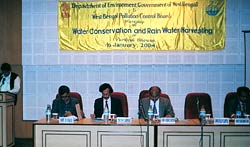 A
one-day workshop on water conservation and rainwater harvesting was
organised by the West Bengal Pollution Control Board (WBPC) on January
16, 2004 in Kolkata. In his welcome address, Dr S K Sarkar, Member
Secretary, WBPC, said that water harvesting was a traditional practice
in India and should be revived. Sukumar Das, Principal Secretary,
State Water Investigation Department, said that not all the blocks
in West Bengal are water bearing. Of the 321 blocks, only 269 blocks
have water potential; the water potential in the remaining blocks
was less due to the presence of laterite, crystalline terrain and
salinity, which severely limits the sources for future extraction
of water. To illustrate, he claimed the water level has fallen from
14m below ground level (bgl) in 1991 to 18m bgl in 2001 in the Park
Circus area. He said the water requirement in 2000 which was around
10.85 million hectare meter (mhm) is projected to rise to 20 million
hectare meter by 2050. The domestic and drinking water requirements
will rise from 0.26 mhm to 0.40 mhm by 2050, making the future of
water supply uncertain. A
one-day workshop on water conservation and rainwater harvesting was
organised by the West Bengal Pollution Control Board (WBPC) on January
16, 2004 in Kolkata. In his welcome address, Dr S K Sarkar, Member
Secretary, WBPC, said that water harvesting was a traditional practice
in India and should be revived. Sukumar Das, Principal Secretary,
State Water Investigation Department, said that not all the blocks
in West Bengal are water bearing. Of the 321 blocks, only 269 blocks
have water potential; the water potential in the remaining blocks
was less due to the presence of laterite, crystalline terrain and
salinity, which severely limits the sources for future extraction
of water. To illustrate, he claimed the water level has fallen from
14m below ground level (bgl) in 1991 to 18m bgl in 2001 in the Park
Circus area. He said the water requirement in 2000 which was around
10.85 million hectare meter (mhm) is projected to rise to 20 million
hectare meter by 2050. The domestic and drinking water requirements
will rise from 0.26 mhm to 0.40 mhm by 2050, making the future of
water supply uncertain.
B K Basu, Chief Engineer, WBPCB, said that considering the unplanned
urbanization in future, WBPCB has issued a " Direction"
date 19th December, 2003. According to this Direction, Municipal Corporations,
Municipalities, Zilla Parishads, Panchayat Samities and Panchayats
will be discouraged from sanctioning any building plan of a housing
complex having 100 flats or more, or those with a super built up area
of 60,000 sq.ft or more, without the prior environmental clearance,
i.e., 'Consent to Establish' issued by the State Board. Subhas Dutta,
CGWB Scientist (Eastern Region), talked about the hydro-geology of
West Bengal and Kolkata. He said that along with water, sand is also
being pumped out. This is due to the unscientific construction of
tubewells. If unchecked, such sand pumping may lead to land subsidence
also. He said that CGWB monitors the water level four times a year,
and the post-monsoon water level is showing a steady decline. From
1987 to 2002, the post-monsoon water level has declined in the Salt
Lake City region. He further said that in Kolkata, the freshwater
aquifer is sandwiched between saline and brackish water-bearing aquifers.
So excess pumping of fresh water will lead to brackish water contaminating
the fresh water aquifers. He said that in South Kolkata, the freshwater
aquifer now extends to between 50 to 100m bgl. Here the freshwater
is floating above the saline water, so excess pumping may lead to
the up coning of saline water.
He also warned that the natural recharge from rainwater is not possible
in Kolkata due to the presence of an impermeable clay layer above
the permeable sand formation. He said that in North Kolkata, freshwater
exists from 40m to 100 m below ground level (bgl), while in Central
and South Kolkata, the level is between 20 to 150m. He says the water
level has dipped from 5 to 9m bgl in Central Kolkata in 2003. A member
of CSE's Jal Swaraj Campaign outlined existing legislations in various
cities in India. He mentioned how the latest ordinance in Chennai
and its followup activities had led to the successful implementation
of RWH in individual houses. He also quoted the case of Delhi where
CGWA has come up with several implementation deadlines.
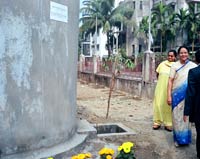 Participants
were also taken to two sites in Kolkata, Poura Bhawan in the Bidhanagar
Municipality office complex, and Bidhannagar Government College, where
they were shown rainwater harvesting structures. In these two buildings
rainwater is stored in a ferro-cement tank of 12,000 liters and the
cost of the each tank is approximately Rs. 22,000. Participants
were also taken to two sites in Kolkata, Poura Bhawan in the Bidhanagar
Municipality office complex, and Bidhannagar Government College, where
they were shown rainwater harvesting structures. In these two buildings
rainwater is stored in a ferro-cement tank of 12,000 liters and the
cost of the each tank is approximately Rs. 22,000.
The site visits were followed by a technical session, in which Dr
T S Bandopadhyay, Director, IWMED, spoke about rainwater harvesting
techniques.
Exhibitions organised by CSE in New Delhi
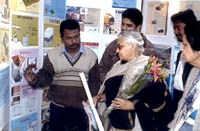 As
a part of its Jal Swaraj Campaign, CSE organised two exhibitions at
Maurya Sherton and at the Indian International Centre (IIC). The two-day
exhibition at Maurya Sherton was held from Febraury 7-8, 2004. The
IIC exhibition was a part of water festival organised by IIC from
February 17 to 22, 2004. CSE participated in both these events by
displaying posters on urban RWH strategies and issues. The poster
series also outlined various methods and techniques of urban rainwater
harvesting. The posters also showcased CSE's model projects. A model
showing the water harvesting system installed in the CSE building
attracted the general public who visited the stall. CSE's influential
publications on water management and RWH were also displayed at the
stall. As
a part of its Jal Swaraj Campaign, CSE organised two exhibitions at
Maurya Sherton and at the Indian International Centre (IIC). The two-day
exhibition at Maurya Sherton was held from Febraury 7-8, 2004. The
IIC exhibition was a part of water festival organised by IIC from
February 17 to 22, 2004. CSE participated in both these events by
displaying posters on urban RWH strategies and issues. The poster
series also outlined various methods and techniques of urban rainwater
harvesting. The posters also showcased CSE's model projects. A model
showing the water harvesting system installed in the CSE building
attracted the general public who visited the stall. CSE's influential
publications on water management and RWH were also displayed at the
stall.
Book release and workshop on rural water harvesting
in Indore
The Hindi edition of the Urban Water Harvesting Manual published
by the Centre for Science and Environment was released by Tarun Bharat
Sangh's Rajendra Singh on February 17, 2004 at a workshop jointly
organised by India Soya Foundation and Rotary Club of Indore city.
The workshop was organised to educate people regarding the alarming
water situation in the region and to motivate them to adopt region-specific
water harvesting techniques and effective water management strategies
to overcome the crisis.In the welcome address O P Goyal, of India
Soya Foudation spoke about the growing water crisis in Malwa reagion
of Madhya Pradesh and the urgent need to restore the deteriorating
situation. In the inaugural address CSE staffer spoke on the current
water (mis)management practices and the increasing levels of dependence
on government. The presentation also highlighted the potential of
traditional water management techniques and its relevance in today's
water stress situation.
Rajender Singh in his speech insisted on mobilising people creating
awareness in the rural areas to conserve rainwater in order to save
the region from becoming a dry zone.
In the workshop Laxman Singh from Jaipur, GT Bhimte from Indore, Vijay
Kedia from Aurangabad and CSE staffer shared various local and cost
effective rural rainwater harvesting techniques with the participants.
The workshop was attended by farmers, village pradhans, government
officials, local citizens and students.
Lecture on RWH for ECO CLUB schools in New
Delhi
CSE delivered a lecture on RWH in a programme organised by The Shri
Ram School, Vasant Vihar, New Delhi, (an Eco Club lead school identified
by Government of Delhi) on February 17, 2004. The target group included
teachers and students from 20 government schools of Delhi.
CSE's lecture focused primarily on water management and rainwater
harvesting. The talk outlined the water scarcity in India and reasons
of scarcity amidst plentiful rains. Uncontrolled exploitation, rampant
usage, polluted water resources are not new in most of the urban areas.
Concepts and principles of RWH was explained by narrating the rich
traditions of rainwater harvesting that existed in India right from
the Indus valley civilization. Starkling experiences
from CSE's Model RWH were also shared during the occasion.
Apart from CSE staffer Manoj Dabbas from (ATTREE) , Vimlendu Jha (We
For Yamuna) spoke about the environmental aspects that teachers must
be conveying to their students while interacting with students.
Anil Kumar from Centre for Environment Education also spoke about
the magnitude of waste water generated in an urban environment and
need to manage it.
|
|






